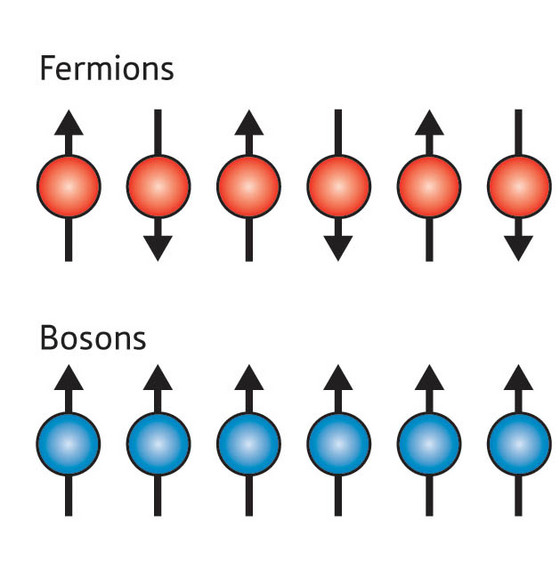Home > Press > A tale of two excitations: A new theory predicts an unusual excitation spectrum for a chain of ultracold gas atoms
 |
| Figure 1: The spins on a chain of fermions (top) point in alternating directions, whereas the spins on a chain of bosons (bottom) all point in the same direction. In the latter case, this leads to the emergence of acoustic and spin wave excitations with markedly different spectra. According to the new theory, such differences should be evident in the way a 1-D system of ultracold bosonic atoms absorbs different frequencies of light. |
Abstract:
Theoretical physicists from Argonne National Laboratory, US, and RIKEN's Advanced Science Institute, Wako, have constructed a general theory for describing the characteristics of an unusual and newly discovered system of particles, a chain of ‘spin-1/2 bosons'.
A tale of two excitations: A new theory predicts an unusual excitation spectrum for a chain of ultracold gas atoms
Japan | Posted on March 6th, 2009Most particles in the Universe are either fermions or bosons. Fermions and bosons may be distinguished by a quantum mechanical property known as spin, which determines a particle's magnetic moment. Fermions, which include electrons and protons, have a spin of 1/2. And bosons, which include photons of light and certain atoms and molecules, always have a spin of 0 or multiples of 1. However, scientists recently discovered that bosons in the form of atoms that have been cooled to a temperature of near absolute zero can behave as if they had a spin of 1/2.
"When certain ultracold bosonic atoms are held in one-dimensional trap, each can be in one of two internal states. These two states can be regarded as up and down components of an effective spin-1/2 particle. Technically, these are referred to as isospin-1/2 bosons, but theoretically there is little difference between spin and isospin," explains RIKEN's Akira Furusaki who, along with Konstantin Matveev from Argonne, built the theory to describe how such particles interact1.
Systems of one-dimensional fermions have been studied for decades because they can be realized experimentally in solid-state systems such as quantum wires and carbon nanotubes. Consequently, their behavior is now well established and described by the so-called Tomonaga-Luttinger theory. Matveev and Furusaki's theory now provides a framework for describing the behavior of a chain of spin-1/2 bosons.
Matveev and Furusaki's theory begins by recognizing that the spins of a chain of bosons prefer to point in the same direction, whereas chains of fermions arrange themselves so that their spins point in alternating directions (Fig. 1). This means that a chain of spin-1/2 bosons can support both acoustic waves―formed by localized fluctuations in the density of particles along a chain―and spin waves―formed by deviations in the orientation of spins along a chain.
The spectra of acoustic waves and spin waves are markedly different, which affects the way in which a chain of ultracold spin-1/2 boson atoms absorbs different frequencies of light. The authors say this provides a relatively straightforward means to test their theory, and gain new insight into the behavior of these and other bosonic systems.
Reference
1. Matveev, K. A. & Furusaki, A. Spectral functions of strongly interacting isospin-1/2 bosons in one dimension. Physical Review Letters 101, 170403 (2008).
The corresponding author for this highlight is based at the RIKEN Condensed Matter Theory Laboratory
####
For more information, please click here
Copyright © Riken
If you have a comment, please Contact us.Issuers of news releases, not 7th Wave, Inc. or Nanotechnology Now, are solely responsible for the accuracy of the content.
| Related Links |
| Related News Press |
News and information
![]() Researchers develop molecular qubits that communicate at telecom frequencies October 3rd, 2025
Researchers develop molecular qubits that communicate at telecom frequencies October 3rd, 2025
![]() Next-generation quantum communication October 3rd, 2025
Next-generation quantum communication October 3rd, 2025
![]() "Nanoreactor" cage uses visible light for catalytic and ultra-selective cross-cycloadditions October 3rd, 2025
"Nanoreactor" cage uses visible light for catalytic and ultra-selective cross-cycloadditions October 3rd, 2025
Physics
![]() Quantum computers simulate fundamental physics: shedding light on the building blocks of nature June 6th, 2025
Quantum computers simulate fundamental physics: shedding light on the building blocks of nature June 6th, 2025
![]() A 1960s idea inspires NBI researchers to study hitherto inaccessible quantum states June 6th, 2025
A 1960s idea inspires NBI researchers to study hitherto inaccessible quantum states June 6th, 2025
![]() Magnetism in new exotic material opens the way for robust quantum computers June 4th, 2025
Magnetism in new exotic material opens the way for robust quantum computers June 4th, 2025
Discoveries
![]() Researchers develop molecular qubits that communicate at telecom frequencies October 3rd, 2025
Researchers develop molecular qubits that communicate at telecom frequencies October 3rd, 2025
![]() Next-generation quantum communication October 3rd, 2025
Next-generation quantum communication October 3rd, 2025
![]() "Nanoreactor" cage uses visible light for catalytic and ultra-selective cross-cycloadditions October 3rd, 2025
"Nanoreactor" cage uses visible light for catalytic and ultra-selective cross-cycloadditions October 3rd, 2025
Announcements
![]() Rice membrane extracts lithium from brines with greater speed, less waste October 3rd, 2025
Rice membrane extracts lithium from brines with greater speed, less waste October 3rd, 2025
![]() Researchers develop molecular qubits that communicate at telecom frequencies October 3rd, 2025
Researchers develop molecular qubits that communicate at telecom frequencies October 3rd, 2025
![]() Next-generation quantum communication October 3rd, 2025
Next-generation quantum communication October 3rd, 2025
![]() "Nanoreactor" cage uses visible light for catalytic and ultra-selective cross-cycloadditions October 3rd, 2025
"Nanoreactor" cage uses visible light for catalytic and ultra-selective cross-cycloadditions October 3rd, 2025
|
|
||
|
|
||
| The latest news from around the world, FREE | ||
|
|
||
|
|
||
| Premium Products | ||
|
|
||
|
Only the news you want to read!
Learn More |
||
|
|
||
|
Full-service, expert consulting
Learn More |
||
|
|
||








